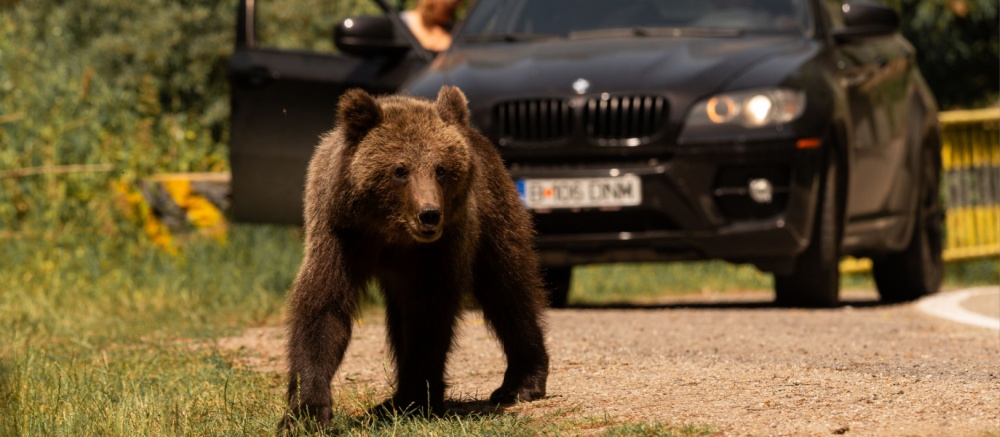Do you know how to react if you come across a bear? Many Calgarians spend their weekends exploring the Rocky Mountains, heading west to Banff, Canmore and Kananaskis for hiking and camping. During those adventures, you never know who you’ll meet, so it’s important to have training in case you come across bears.
Bear awareness training is a life-saving skill. From understanding bear behaviour to learning how to respond in an encounter, this training provides outdoor enthusiasts with the knowledge and confidence they need to enjoy nature safely. Bear awareness training in Calgary is essential to preparing for a safe, responsible outdoor experience.
What to Do if You Encounter a Bear
Most confrontations between bears and humans can be avoided. You just need a clear understanding of what to look for and how to stay safe while you are enjoying nature. Here are a few quick tips:
Beware of bears. The first step is to remember that you are a guest in the bear’s home when you are out on nature trails and in the mountains. When exploring, the goal is to avoid disrupting or surprising the local wildlife—especially a bear that has just woken up from a winter nap.
Make noise. The best way to avoid an encounter with a bear is to make sure that you make noise. Bears will often try to avoid interacting with humans as much as we try to avoid them. We recommend travelling in groups, having conversations, singing or wearing bear bells to make noise on the trail. If you are in an area with lots of trees, wet moss or rushing streams, you will want to make even more noise. These natural elements will absorb sounds and human scents, and make it easier for you to surprise a bear.
Keep your ears open. While you are making noise, always make sure that you are listening for noises coming from the area around you. Listen to trees being moved or sticks breaking in the trees. Bears are very large and will often alert you to their presence with the sounds of them moving through the trees. Do not wear headphones or earbuds while on trails.
Watch for fresh bear signs. You’ll want to keep your eyes open for any signs that a bear has recently been in the area. Look for fresh tracks, scat, and digs that could indicate that a bear has been there before you. Leave the area immediately if the signs are fresh or if you encounter any freshly killed animal carcasses.
If you encounter a bear, stay calm. Do not approach the bear or run away from it. Speak in a calm voice to let the bear figure out what you are. Back away slowly and don’t make eye contact.
Steer clear of babies. It’s also important to remember that in the spring, bears will have their cubs with them and are very protective. If you see a bear cub, give the bears extra space and back away from them. Do not take photos. Do not ever get in between a mother bear and her cubs.
Know how to use bear spray. If a bear approaches or follows you, you may need to use bear spray. Make sure that you know how to use bear spray before you hit the trails though. Our AIP’s Bear Awareness Training Course covers everything you need to know about properly using bear spray.
Take a Bear Awareness course. AIP Safety offers a four-hour training course that will give you all of the information you need to better understand the nature of bears and how to identify, avoid and prevent bear encounters in order to keep yourself, the bears and those around you safe. The course will take you through classroom theory and real-life scenarios. We recommend that you take this course if you enjoy outdoor activities in Alberta’s foothills and mountains or if you work in a remote area where bears live.
Reasons to Take Bear Awareness Training
With the bear population on the rise, it’s more likely that you’ll encounter one during your time exploring the outdoors. In fact, black bears are extending their range, and the calculated average density is 84 bears per 1000 km². As of 2021, it’s estimated that there are between 856 and 973 grizzly bears in our province.
We want to be able to co-exist peacefully with grizzly and black bears in Alberta, and most confrontations can be avoided with the proper training. Here are some great reasons why training is important.
Enhance Personal Safety
Bear encounters can happen unexpectedly, especially when hiking or camping in bear habitats. Bear awareness training provides you with the knowledge and skills to respond calmly and appropriately during an encounter. Understanding bear behaviour, such as defensive versus non-defensive actions, can help outdoor adventurers react in ways that minimize risk, reducing the likelihood of dangerous situations.
Knowledge of Bear Behaviour and Habitats
Training helps participants recognize bear activity in their surroundings, such as identifying tracks or signs like scat and claw marks. Hikers and campers can better plan their routes by learning how to avoid high-risk areas, such as berry patches or active bear habitats. Knowing where bears are likely to be present, especially during spring, when they emerge from hibernation, is critical for personal safety.
Confidence in Handling Bear Encounters
In a bear encounter, panic can lead to poor decisions, such as running or making sudden movements, which may provoke an attack. Bear awareness training teaches people how to use bear spray effectively and the proper techniques to de-escalate encounters, such as standing your ground, appearing larger, and calmly backing away. This training fosters confidence, helping outdoor enthusiasts handle situations without fear.
Protecting Alberta’s Wildlife
Bear awareness training is learning how to protect yourself while respecting wildlife. When people understand the behaviours and needs of bears, they are more likely to take precautions like storing food properly and keeping a clean campsite. This protects human lives and prevents bears from becoming food-conditioned, which can lead to more frequent human-bear interactions and the possible need for bear relocations or euthanization.
Legal and Ethical Responsibility
In Alberta, it is an ethical and often legal requirement to be prepared and bear aware when venturing into wilderness areas. Many parks and outdoor recreation zones have regulations in place to ensure the safety of both humans and bears. Bear awareness training helps outdoor enthusiasts adhere to these regulations, fostering a safer environment for all.
A Must for Outdoor Enthusiasts and Families
For those who love outdoor activities like hiking, camping, and backpacking, especially with family members, bear awareness training is an invaluable investment. It ensures that even young hikers know how to behave safely in bear country, making outdoor adventures safer and more enjoyable for everyone.
Bear Awareness Training in Calgary from AIP Safety
If you’re planning to explore the great outdoors or work in remote areas where bear encounters are possible, AIP Safety’s 4-hour Bear Awareness Training is essential for your safety and that of those around you. By taking this course, you’ll gain a deep understanding of bear behaviour, identification, and strategies for avoiding encounters.
Whether you’re an outdoor enthusiast or a worker stationed in bear habitats, this training equips you with the knowledge and skills to navigate these environments responsibly. Upon completion, you’ll receive a certificate valid for three years, ensuring you’re prepared to co-exist safely with the rising bear population in Western Canada.
Contact us today to book your Bear Awareness Training in Calgary, or visit our website to explore our other courses.

